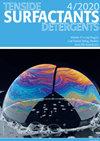Dilute hydrochloric acid induced switching from antagonism to synergism in the binary mixed systems of cocamidopropyl betaine (CAPB) and sodium dodecyl benzene sulfonate (SDBS)
IF 1.2
4区 工程技术
Q4 CHEMISTRY, APPLIED
引用次数: 1
Abstract
Abstract A synergism is reported in the binary mixtures of cocamidopropyl betaine (CAPB) and sodium dodecyl benzene sulfonate (SDBS) at mole fractions of 0.25, 0.50, and 0.75, in dilute hydrochloric acid solutions (∼0.05 M) HCl, at 25 °C. Such synergism is confirmed by surface tension values, critical micelle concentration (CMC), and interaction parameter values according to Holland and Rubingh’s model and the satisfaction of Hua and Rosen conditions. Surface excess (Γ) at air/water interface and the minimum area occupied by surfactant molecule (A min) also indicated a reduction in the A min of mixed CAPB/SDBS compared to single surfactants that is due to the strong electrostatic interaction between surfactants heads. The composition of CAPB/SDBS mixed micelles, the interaction parameter (β) and the micellar activity coefficients (f 1 and f 2) were evaluated from the regular solution model for these binary amphoteric/anionic mixed systems. It is clear the CAPB surfactants are converted to the cationic form by charging in the presence of HCl, which enhances the interaction between the oppositely charged CAPB and SDBS heads and overcomes the unfavourable packing between the tails predicted in pure water. Such strong interaction was also reflected on the phase behavior of CAPB/SDBS binary mixed system. Accordingly, a switching from antagonism to synergism is reported for CAPB/SDBS binary mixed system in the presence of dilute hydrochloric acid.稀盐酸诱导椰油酰胺丙基甜菜碱(CAPB)和十二烷基苯磺酸钠(SDBS)二元混合体系由拮抗转向协同作用
摘要:本文报道了椰油酰胺丙基甜菜碱(CAPB)和十二烷基苯磺酸钠(SDBS)的二元混合物在25°C的稀盐酸溶液(~ 0.05 M) HCl中,摩尔分数分别为0.25、0.50和0.75时的增效作用。这种协同作用通过Holland和Rubingh模型的表面张力值、临界胶束浓度(CMC)和相互作用参数值以及满足Hua和Rosen条件得到证实。空气/水界面的表面过剩量(Γ)和表面活性剂分子占据的最小面积(A min)也表明,与单一表面活性剂相比,混合CAPB/SDBS的A min减少,这是由于表面活性剂头部之间的强静电相互作用。利用常规溶液模型对CAPB/SDBS混合胶束的组成、相互作用参数(β)和胶束活性系数(f1和f2)进行了评价。很明显,在HCl的存在下,CAPB表面活性剂通过充电转化为阳离子形式,这增强了相反电荷的CAPB和SDBS头部之间的相互作用,克服了在纯水中预测的尾部之间的不利堆积。这种强相互作用也反映在CAPB/SDBS二元混合体系的相行为上。因此,报道了在稀盐酸存在下,CAPB/SDBS二元混合体系从拮抗到协同的转变。
本文章由计算机程序翻译,如有差异,请以英文原文为准。
求助全文
约1分钟内获得全文
求助全文
来源期刊

Tenside Surfactants Detergents
工程技术-工程:化工
CiteScore
1.90
自引率
10.00%
发文量
57
审稿时长
3.8 months
期刊介绍:
Tenside Surfactants Detergents offers the most recent results of research and development in all fields of surfactant chemistry, such as: synthesis, analysis, physicochemical properties, new types of surfactants, progress in production processes, application-related problems and environmental behavior. Since 1964 Tenside Surfactants Detergents offers strictly peer-reviewed, high-quality articles by renowned specialists around the world.
 求助内容:
求助内容: 应助结果提醒方式:
应助结果提醒方式:


